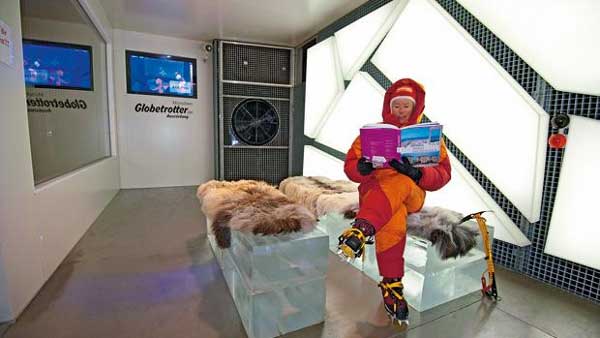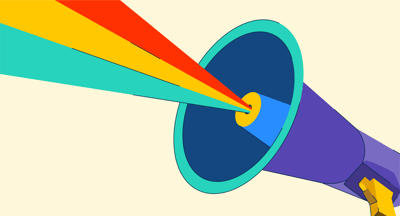November 8, 2024
 by Kristen McCabe / November 8, 2024
by Kristen McCabe / November 8, 2024

In a world saturated with advertisements and digital distractions, capturing consumer attention has become more challenging than ever.
Whether it’s a captivating pop-up event or a memorable brand activation, experiential marketing creates moments that leave a lasting impression and build genuine connections between brands and their audiences.
Experiential marketing is a strategy that focuses on creating immersive in-person experiences for customers and prospects. It helps foster meaningful relationships and engagement beyond traditional marketing methods.
Experiential marketing can be disguised as a variety of other marketing strategies. Let’s take a look at each of them:
Event marketing and experiential marketing go hand in hand. While all events can be considered experiential marketing, not all interactive marketing experiences are events.
What does that mean? An event, by nature, provides an experience. There is a set time for tangible, face-to-face interactions.
However, not all experiential marketing campaigns are events. Events require tickets, a set time, and a place. Guests plan to attend them in advance. Email reminders are sent out, and a dedicated team promotes the event before the day.
Engagement marketing does not always require as much promotion. While you may want to send out a press release and share the event on social media, engagement marketing has an element of surprise. You often won't send an email inviting your subscriber list to book tickets. Brands are also turning to UGC tools that make it easy for attendees to capture and share event moments, extending engagement well beyond the venue.
For an example of event marketing that is also experiential, consider event sponsorships, such as the installation at the POPSUGAR Play/Ground festival for women.
Attendees of the inaugural festival had the opportunity to spin the Kohl’s Cash wheel and win coupons worth $10, $20, or $50 in Kohl’s Cash or even a $200 gift card.

Image source: Service Graphics
I’m not going to lie. I see that wheel, and all I want to do is run up and give it a spin, even the picture is irresistible. (Perhaps it comes from watching one too many episodes of “The Price is Right” growing up!) That desire to engage with Kohl’s makes this a perfect example of engagement marketing at an event.
Brand activation refers to the launch of a company’s new line, product, or service. It is a perfect opportunity for experiential marketing, as companies want to get media coverage and let consumers know their new product is available. They need this to create demand for the new products as it’s much easier to sell an item when customers know it already exists in the market.
One of the best ways to practice experiential marketing in brand activation is through product sampling.
Astound Group, a design and fabrication company, used this strategy to raise awareness and launch three new flavors of Teavana Shaken Iced Tea while working with Starbucks and Teavana.
The company created a mobile pop-up that toured summer festivals throughout the country. At each festival, attendees could stop by the tent to rest their feet on one of the fruity bean bag chairs and taste the new product.

Image source: Astound
The colorful fruit on top of the tent earned the attention of festival-goers in a crowded space. Once at the tent, attendees could choose one of the three new flavors they would like to order. An experienced barista prepared their drink fresh on the spot.
To increase the exposure outside of each festival, pop-up guests were invited to share a picture with their tea on social media, including the campaign’s designated #goodfeelsgood hashtag.
Like events, guerrilla marketing, and engagement marketing go hand-in-hand. They both involve the element of surprise, often by creating an unexpected display or experience. The surprise is there to incite conversations around the campaign.
Guerrilla marketing is not a traditional advertising campaign with money spent on paid media. For example, sponsorships are not guerrilla marketing. This is why the approach is also known as “ambush marketing.” It often does not ask for permission and risks causing legal issues and misunderstandings.
Guerilla marketing must involve an experience or element of interaction for it to be experiential. Here is an example of guerrilla marketing that doesn't have an experiential element.
Budweiser spent millions of dollars to sponsor the 2010 Fifa World Cup. That didn’t stop Bavaria, a beer company in the Netherlands, from putting 36 young women in bright orange dresses throughout the stadium of one game.

Image source: BBC News
While the story did get headlines, Budweiser and Fifa were less than pleased. The women were forced to leave the stadium and threatened with six months in jail, and two were arrested.
Thankfully, not all guerrilla marketing is illegal. Consider Casino Di Venezia's Venice Marco Polo airport campaign for an example of marketing that executes both guerrilla and experiential marketing.
Instead of the standard black rubber conveyor belt carrying your luggage to you, Italian advertising agency Admcom turned the baggage claim into a giant roulette wheel.

Image source: Oddee
This campaign would, no doubt, have received approval from the airline and payment for the ad’s placement. The roulette baggage claim does, however, still have the surprising element of guerrilla marketing while also providing the experience of engagement marketing.
Are you someone who loves browsing through stores or hates shopping and resigns to sitting bored in the corner?
Either way, experiential marketing gets customers of all kinds into stores and then extends their time.
Engagement marketing in a retail setting intrigues even the most uninterested customers. Joyful shoppers like myself are entitled to a few more moments of guilt-free shopping thanks to our partners’ momentary amusement. The more interactive the display, the longer consumers can be exposed to your products and potentially buy.
For example, there's only so much time my husband will spend in Topshop. If I let him experience a virtual water slide, he will give me time to try on a few more dresses!

Image source: VR Scout
Experiential marketing is a critical asset for retail shops in the age of online shopping. Even shopaholics like me are regular participants in e-commerce. Between companies like Amazon and Walmart offering two-day shipping and the ability to find what you want at your fingertips, what’s not to love?
Like omnichannel marketing, bricks-and-mortar stores have something online retail doesn’t -- the opportunity to interact and engage face-to-face, providing an authentic experience.
Stores have now moved from a place to buy things to branded environments. Strategy and design company Consortia has even created a diagram of the branded spaces in New York City.

Image source: Consortia
In the image, you can see the vast white emptiness on the left; the more a space focuses on shopping, the less experiential it is. Knowing that the value of engagement marketing comes down to the experience, you can see how brands in the Big Apple have found the sweet spot right in the middle between experiences and shopping. Others, like Nespresso, have moved to full-on experiential by offering classes.
An example leaning towards the pure experience side is Hub Seventeen at Lululemon.
Lululemon’s flagship store in Manhattan’s Flatiron District opened in November 2015. The store offers much more than extensive shopping, including a concierge service and its unique community space, Hub Seventeen.
Lululemon’s general manager of U.S. retail explained Hub Seventeen and why it is vital to the brand: “Innovation is at our core, from our technical product design to our unique guest experience. While all our stores offer in-store yoga and fitness classes and events, Hub Seventeen is the first time we have created a dedicated community space separate from the retail experience.”

Image source: WorkFrom
Hub Seventeen's website is separate from the online retail store. It offers yoga and fitness classes, gallery nights featuring local artists, and workshops. This true brand interaction makes Lululemon more than an activewear brand. Hub Seventeen and the experiences it provides make Lululemon a lifestyle brand.
Now that you know the benefits of experiential marketing and the ways you can execute the strategy, let’s look at some best practice guidelines to keep in mind.
Whether this is your first, tenth, or hundredth experiential campaign, it’s important to remember how the strategy relates to your marketing and company goals.
Experiential marketing campaigns create go beyond traditional advertising by fostering emotional connections and encouraging active participation.
Let's explore some of the most impactful experiential marketing campaigns:
In 2012, Red Bull executed one of the most extraordinary experiential marketing campaigns in history with the "Stratos" project.
This groundbreaking initiative featured Austrian skydiver Felix Baumgartner, who ascended to an astonishing altitude of approximately 24 miles—about 128,000 feet—above Earth before making a historic freefall jump. Baumgartner not only set the record for the highest jump but also became the first person to break the sound barrier without the protection of an aircraft.
The Stratos event was more than just a daring stunt; it was a meticulously planned publicity spectacle that captured the world's imagination. The jump was live-streamed on YouTube, attracting over eight million viewers, and generated extensive media coverage across various platforms.
This monumental achievement not only showcased Red Bull's commitment to pushing boundaries but also solidified its position as a leading brand in the energy drink market, reinforcing the company's image of innovation and adventure.
IKEA hosted a unique sleepover event in one of its stores, inviting customers to spend the night in the showroom. Attendees enjoyed activities like sleep-related workshops, bedtime stories, and a cozy atmosphere.
This campaign not only generated buzz on social media but also showcased IKEA's products in a fun and immersive way, allowing customers to experience the comfort of its furniture firsthand.
Note: Curious about the most innovative experiential marketing strategies? Explore few more experiential marketing campaigns.
Many traditional marketing tactics involve companies pushing out their messaging to consumers through commercials, print ads, and (shudder) telemarketing. These are the messages that many customers don’t want. Depending on the execution, outbound marketing can give marketers a bad name.
Experiential marketing works because it breaks this mold. It’s not about fast-forwarding through commercials on your DVR or flipping past the advertisements in your magazine. Interactive marketing is different from commercials, people WANT to interact with it.
Whether you are executing B2B or B2C marketing, I sincerely believe marketing does not have to be boring. Scratch that, it should not be boring. And there is no better place to beat boring campaigns than experiential marketing.
People want to be unique; they want to feel special. Emotional marketing has grown manifold in the past three years. A large number of consumers, when you provide individuals with an experience that makes them stand out on a social media feed, will undoubtedly share it.
One of the biggest benefits of experiential marketing is social media marketing. These experiences are tailored to customers, so those participating want to share them with their friends. Because they have an aspirational quality (or, for lack of a better phrase, by “being cool”), social media shares are sure to be present on every platform.
Measure shares with social media monitoring platforms to identify trending topics or phrases and gain insights into engagement through organized user information.
Experiential marketing is designed to get people talking. Social media can be one form of word-of-mouth marketing - people share stories, news, and opinions with their networks.
However, you can’t underestimate the power of individual and interpersonal communications. Peer recommendations are still more valuable than any other form of marketing. When it comes to peer feedback and customer reviews, marketers across industries realize the importance of customer reviews.
B2B buyers are more likely to purchase after reading a trusted review.
Source: G2 and Heinz Marketing
Experiential marketing is one of the best possible ways to start those conversations. While there’s no way to measure the discussions one has about you with friends and family, you can’t underestimate their value.
Experiential marketing doesn’t just get customers talking about your brand, it gets them talking in the best possible way. Positive connections with your customers can increase short-term sales and grow brand loyalty.
While growing brand loyalty is a common phrase in marketing, its importance goes beyond being industry jargon.
People who swear by their favorite brands will often tell you about their love for its products and indirectly raise brand awareness. Many brands use media monitoring software to track customer sentiments, provide a delightful customer experience, and build loyalty.
The best experiential marketing campaigns get you an extensive audience for your efforts, not just through your customers but also newspapers, blogs, television, and other broadcast media. If you ask me, it's a golden lesson in generating free PR for your brand.
For example, in 2015, 13 tons of candy covering 14,000 square feet were carefully placed together in Chengdu, China, to promote the IFS shopping center.

Image source: Inhabitat
Here are just a few of the headlines that resulted from the 607-foot-long candy carpet:
Invite news publications and influencers to a sneak peek at your event before it opens - it gives them an intriguing news story separate from the doom and gloom that happens before your event. This is how you can get people excited to come and interact with your brand before the experience occurs.
Like all types of marketing, experiential marketing has best practices. Here are seven best practices to consider when implementing your experiential marketing campaign.
Customers having positive memories of interacting with your experience is great. But what if those memories don’t tie back to your brand? It pretty much defeats the purpose of experiential marketing.
Lululemon is the perfect example of an offering experience that ties into the brand. It doesn’t just sell activewear. Its stores are the destination for customers to wear it. Given that its clothing is worn when practicing yoga, which has an element of mindfulness, the company also offers workshops designed to promote this principle.
For example, in December 2015, it held a “Transcend Holiday Madness Meditation” event.

Image source: Hub Seventeen
Another company with an in-store experience intertwining its brand and target market is the clothing store Missguided.
The 20,000-foot flagship space in East London opened in November 2016, and there weren't just unicorns. Vending machines were selling the dreams and tears of this beloved mythical creature.

Image source: Prop Studios
In addition to unicorn dreams, there were hashtag props, frosted doughnut tires, and a bejeweled pink monster truck.
Prop Studios, which created these interactive features, shares the experiential part of the goal: “Looking at online competitors and bricks-and-mortar market leaders that Missguided was about to disrupt, we looked for that point of difference to what Missguided would be as an experience.”
The store set itself apart from competitors by creating an experience that would resonate with its customers.
Why are you executing this campaign, and what do you want it to achieve?
Experiential marketing, by nature, has many benefits that can’t be ignored, including interacting with your customers, building relationships, and raising brand awareness.
For your experiential marketing to be successful, you must get specific. Answer the following questions:
Some benefits of interactive marketing, such as brand affinity, are valid and important. However, they are difficult, if not impossible, to track accurately. It’s imperative to measure what you can.
While brand awareness and affinity are essential to growing lasting customer relationships, you need elements you can measure. In addition to guiding your strategy, marketing spending must be justified by a company’s decision-makers. Finding ways to track experiential success gives you a tangible way to back what you did and why.
The Bumble Fab Lab in Sydney, Australia, created an experience tied to its brand and with specific measurable goals.
Bumble is an app initially designed for dating. It has now become a social networking app for relationships, including looking for friends or expanding professional connections. Given this, in 2017, the marketing team’s goal was to educate potential users that the app was now open to everyone—even if they weren't single.
The company created a truly interactive experience to expose new users to its brand. Based on the event’s description on Facebook, I cannot think of a better example of experiential marketing: “Get ready to...taste, smell, see, and create, all in the one place.” It’s the definition of engaging the senses!
And, watching this video, it’s safe to say it executed with flying colors:
Source: Bumble - The Bumble Fab Lab from Banter
Another of the company’s goals is to give value to its users, and the event was a perfect way to do so.
In this Bumble Fab Lab example, success metrics included measuring foot traffic and feedback. Because downloading the mobile app was the only requirement for entry, the experience also resulted in a higher number of users. The number of app downloads is a goal that could be measured. The company also looked at media coverage.
The measurements you can take when looking at your event’s success include:
When looking for ways to measure your success, think about the action you want attendees to execute. This, combined with your measurable goals, will ensure you can back up the logic behind your campaign.
Devoting your company’s revenue to 14,000 square feet of candy might not make sense to your accounting department. As a marketer, you have the metrics we just mentioned, such as publicity and social media shares, to measure your effectiveness.
Your CEO and finance team don’t care about social media shares if they don’t result in revenue. Think about the actions people can take to serve goals company-wide, not just your marketing team.
Take this example from Globetrotter, a German company that provides sporting and outdoor equipment. Is that jacket as warm as it looks? Before lining up at the cash register, customers at the Globetrotter store can test new gear.
Stores were outfitted with rooms designed to simulate the experience the clothing was designed for, including freeze chambers with temperatures as low as negative 30 degrees Celsius.

Image source: Zipwolf
Eager for a hike but prefer to stay above-freezing temperatures? Instead of a freezing chamber, you can test jackets, boots, pants, and more in a rain room with pouring water and storm-grade winds.
The action for customers is simple: buy the clothing Globetrotter sells. Letting customers experience the products in real-life elements eliminates the fear of purchasing.
People are afraid products won’t do what they say they will. By getting to test them out before purchasing, customers are assured the jackets, boots, and hats will fulfill the promise on the tag, keeping them warm and dry when facing extreme elements.
Robert Cialdini is the author of “Influence: The Psychology of Persuasion.” With nearly 2,000 reviews on Amazon, it is one of the most well-known books on the art of persuasion.
The book contains six principles of persuasion. One of those principles, scarcity, applies to every instance of experiential marketing: it is unique. It’s not an experience that customers can find at any time or place; it is usually short-lived.
Cialdini explains that people want something more when it is in short supply. This principle is familiar to us all, and it even has an acronym: FOMO—fear of missing out.
Get people excited about your experience by emphasizing it’s a limited opportunity. If they don’t take it right now, with you, they won’t have the chance to do so again.
Netflix created hype around its immersive “Because You Watched” pop-up experience by offering it for just one weekend in June 2018. The limited-time offering increased the value of tickets and gave them an air of exclusivity.

Image source: Entertainment Weekly
With displays ranging from neon characters to an infinity room, social media opportunities were abundant. Blog posts leading up to the event included this in the promotion, stating, “Prepare for the most Instagrammable weekend of your life.”
In addition to creating hype, the short-lived event gave Netflix a wide range of media coverage, extending to major news outlets such as ABC News.
Netflix is no stranger to creating short-lived events that people want to attend. As part of its Gilmore Girls launch in 2016, the company created a real-life Luke’s Diner in every 50 states. The catch? The diner was open for one day at each location, from 7 a.m. to 12 p.m.
People waited hours in lines that extended down multiple blocks. The lines even increased the social media conversation:

Image source: Twitter
The campaign was covered in well-known publications, such as Glamour magazine.
Creating hype before a limited opportunity ensures people are motivated (in these cases, extremely motivated!) to book their tickets and plan. It also gives media publications an extra reason to cover the experience. Before the event, media outlets are doing their viewers a favor, alerting their consumers of the need to buy tickets. After the event, high turnout and long lines provide the perfect story for evening news coverage.
Finding an event partner offers substantial benefits.
You are doubling the resources you have to put into the event, including employees and their ideas. One of the best ways to get creative campaigns is through collaboration.
Cross-promotion has substantial benefits. If you can find a company to partner with a similar target market but whose product offerings differ, you can reach new audiences. And, thanks to the guerrilla aspect of interactive marketing, you don’t even have to plan the partnership ahead of time!
One of the most well-known examples of interactive marketing is the “Zappos Google cupcake ambush.”
Google started the experiential initiative with its “pay with a photo” campaign, handing out free gourmet cupcakes. The payment for a sugar hit? Individuals were given an to find their phone's pictures in 20 seconds.

Image source: AdWeek
It was, no doubt, a great example of experiential marketing. Then, Zappos stepped in and took it to the next level. Zappos came along and set itself up next to Google’s fancy cupcake truck, appearing to be nothing more than a cardboard box. But it was so much more. Instead of buying an item with a photo, Zappos allowed people to #PayWithACupcake.
People received high-value items such as watches and sunglasses in exchange for the cupcake.
Watch the video and see the campaign in action for yourself. I love seeing the giant cardboard box run away like a mischievous child.
Image source: YouTube
Social media exposure is both a benefit and a goal of interactive marketing campaigns. Knowing this, you can set yourself up for success by making it easy for people to share your event on social media.
Just like events, experiential campaigns can have a designated hashtag created around the project. This is often the case for experiential projects executed on a large scale or with national exposure, such as Zappos' #PayWithaCupcake.
For another example of how to make your event shareable, consider Lean Cuisine. In 2015, the company constructed an interactive art wall at Grand Central Station in New York City. The wall was designed to remove the anxiety and negativity of stepping onto a bathroom scale.
Lean Cuisine’s customers were asked to “weigh in on what matters” on social media. The answers were then painted onto the individual scales by artist Annica Lydenberg. Social media was also a part of the event installation itself, with the hashtag being an integral part of the design.

Image source: Event Marketer
Anyone wanting to take pictures of the wall and share them on social media knew exactly what hashtag they needed to participate in social media conversations. Lean Cuisine also shared its social media handle, making it easy to include them in online mentions. And it worked - Lean Cuisine saw a 428 percent increase in social media mentions.
Not all experiential marketing is memorable, but the best campaigns are.
Take event marketing, for example. While all events are experiences, as shown throughout this article, the branded experiences we remember and share require more than a date, time, and location. If you are hosting events as part of your marketing strategy, look for ways to include interactive elements at the event.
This also applies to corporate conference planning. For example, Dreamforce, the annual conference run by Salesforce, has a climbing wall. Smaller events and sponsor booths can still find ways to engage attendees with games.
Look at the examples shared throughout this article. How many of them do you expect to see when walking down the street on an average Saturday afternoon?
For example, consider Orchard Valley Harvest’s mobile orchard. Instead of leaving the city to enter the relaxing oasis, it traveled through major cities as a bus.
Source: YouTube
Out Cold, the agency that created the campaign for Orchard Valley Harvest, shared that this video “was to create a moment of surprise and relaxation for consumers and tie those emotions to the wholesome goodness of Orchard Valley Harvest snacks.”
Sitting on a swing enjoying your wholesome snack in the middle of the urban jungle is a surefire way to make sure your brand is remembered and puts a smile on peoples’ faces.
Experiential marketing is where your creativity shines. To excel in this strategy, you can’t be afraid to take risks and step outside your comfort zone. A bigger budget is often involved, but the payoff regarding social media shares, loyalty, and brand awareness is worth it.
Find ways to measure what you can and brainstorm with a genuinely open mind. If your budget allows it, partner with an agency to guide you through unexpected moments and technicalities, such as city permits. The memories you create from your experience will have people looking back on their engagement with your brand with a smile for years to come.
And, above all else, remember to keep it fun!
Discover how to maintain brand consistency and accelerate growth.
This article was originally published in 2018. It has been updated with new information.
Kristen’s is a former senior content marketing specialist at G2. Her global marketing experience extends from Australia to Chicago, with expertise in B2B and B2C industries. Specializing in content, conversions, and events, Kristen spends her time outside of work time acting, learning nature photography, and joining in the #instadog fun with her Pug/Jack Russell, Bella. (she/her/hers)
Experiential marketing goes beyond selling products; it’s about creating interactions that...
 by Sagar Joshi
by Sagar Joshi
The economy started with commodities.
 by Natalka Antoniuk
by Natalka Antoniuk
This was originally published in Adweek.
 by Amanda Malko
by Amanda Malko
Experiential marketing goes beyond selling products; it’s about creating interactions that...
 by Sagar Joshi
by Sagar Joshi
The economy started with commodities.
 by Natalka Antoniuk
by Natalka Antoniuk


